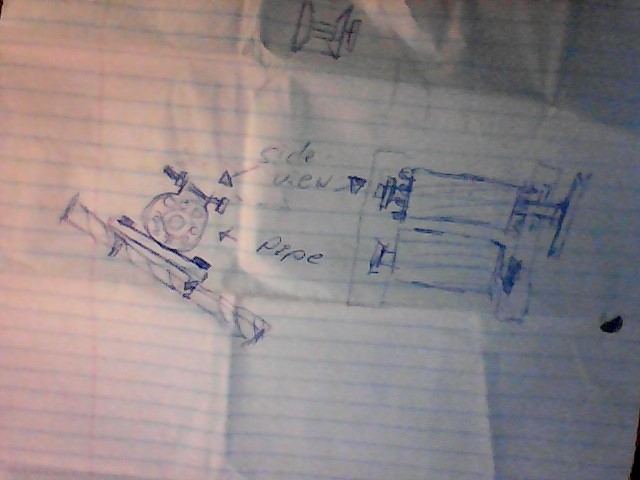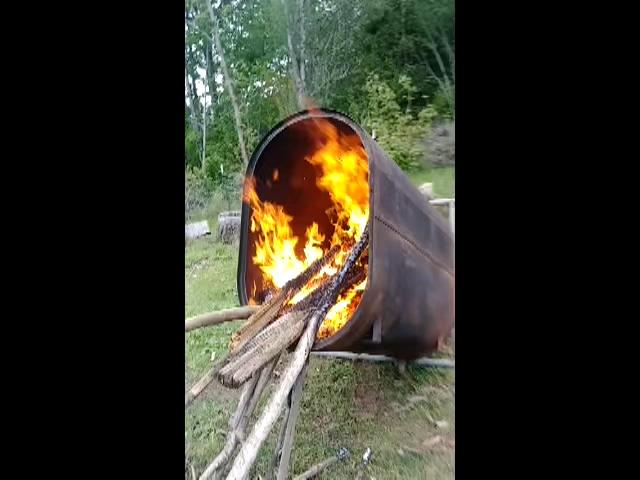Japanese grills are quite popular here now, every other restaurant got one. They are called Konro or Hibachi.
That binchotan charcoal would be difficult to grind so it could be used in a gasifier but it would probably work really well.
Japanese grills are quite popular here now, every other restaurant got one. They are called Konro or Hibachi.
That binchotan charcoal would be difficult to grind so it could be used in a gasifier but it would probably work really well.
Ya I thought a lot about that.
I think we are grinding the wrong way.
When I used to make beer we did not grind grist because that tore the grains and made dust. We crushed between steel rollers. Its worth experimenting to see if crushing between rollers is better than fingers or jaws.
WHAT IS THIS GUY DOING???
My mill was turning 150 rpm.
Haha he’s in a real hurry getting his beer ready.
If I was to build one of these for charcoal what gap would I set between the rollers?
I don’t know I guess the ideal situation would be set the rollers to the width corresponding to the size you want. Some pieces might slip through longer than you like but I think that’s OK if you want to screen the product after…
I made mine much the same as the one on the video.
I used some brong bushings from a hardware store and made the rollers out of pipe welded to some end caps and cold rolled steel rod. That was 20 or more years ago I made that…
Much easier I think would be get a couple of electric motor rotors and bearings and use the rotors as rollers bearings are pretty easy to improvise a flange or cap for bearings and the shaft is already keyed for a pulley.
I am going to make up some doodles and post them to show you what I mean.
I have doubts on whether just rollers without teeth welded on will work. I know for sure that the welded teeth that pulls the varying sizes of charcoal through the “comb” works very well and produces consistantly sized engine grade charcoal. Theoretically a twig of char 3/8" by whatever the length of the rollers are could slip through without teeth to size it for length. Just my 2 cents worth.
I recently found that big dumpster roller so I’m planning to use that as a crusher. From what I’m seeing if someone did a smooth roller you’d need to spin both ends, but with the toothed roller you just need a stationary comb and spin just one drum.
With toothed crushers you just space the gaps 1/8" apart, right?
I think the diameter of the rollers would need to be large enough and it might help to have the surface of the driven roller Knurld ( I did that on my grist mill )

The rotors should be pretty easy to get I would stop by an electric motor shop and see if they have any scrap motors you could buy some parts from. Odd are they have all kinds and all sizes and they are already in pieces.
I did mine 3/8" apart and 3/8" deep.
I was just watching this and thought a fellow could make some very large diameter rollers out of wood. Charcoal will eventually wear them out I guess…
I have a totally simply charcoal grinder. It’s a ugly piece of crap but I’ll pull it apart and show pictures. It’s just a piece of 3 inch ID pipe about eight inches long, cut in half with a plate welded to it to form a J shape. Another piece of 2 and 1/2 OD pipe with half inch pieces of all thread are welded across that and it has a shaft running thought the middle. The smaller pipe turns in the larger and nothing bigger than half inch can emerge. You could make the all thread any size you wanted but you would have to adjust the size of the J or the roller. it turns by hand with a crank. I made it in a couple hours when I first found I needed that size charcoal for fuel. Just dumping chunks in it and cranking on the handle and I can grind five gallons of fuel in about 10 minutes. Of course you have to sift out the fines.
Yeah let’s take a look at it, I’m having a hard time picturing it based on the description.
Im with Don here. Bulk charcoal realy doesent like to flow. Even on my pegged drum grinder occasionaly it spins freely with a full hopper because the char doesent fall down. There is no way a roller wil be able to pull it down.
Second, a barley grain and a peace of charcoal are 2 different beasts. Barley has the outer shell and the whole point is not to break it as it aids filtration later in the brewing process.
Charcoal doesent. I think the crushing action on the whole surface of the roller wuld make more dust.
On a pegged drum grinder you realy just have 3 points of contact…
I made a video of my charcoal processing system but got the phone turned backwards for part of it. Not realizing this I then disassembled the grinder. I’ll redo it later and post.
We make a lot of charcoal using open drum burners. Similar to pit burning, cone kilns, and other open methods that use the ‘flame cap’ method.
They are undoubtedly less efficient than a well insulated design, but I’m pretty sure it is the easiest and cheapest way to make large amounts of charcoal while producing almost no smoke (with dry fuel and careful tending).
The trade off (there always is one) is that you have to feed smaller amounts of wood over time. Typically I have to feed every ten minutes or so.
Full Disclosure: we make and sell wood/charcoal forges and intend to sell charcoal making carts as seen in the video.
Chuck from Oregon
Charcoal in a 55 gal drum
Hey that’s a pretty informative way to make char on the cheap. Thanks for the video!
Similar to Don Mannes burner, a 200 gallon oil drum with the end cut out and set at an angle makes a relatively large amount of charcoal at one time. Very easy to make 150 gallons of charcoal in six hours of intermittent feeding.
Pros: very easy to make, makes large volumes of char, cheap, almost smoke free with dry fuel, will char wet wood with easy (because of the very large fire)
Cons: intermittent feeding (every ten minutes or so, depends on fuel size), not terribly efficient, requires a tractor to move easily
Chuck from Sandy, Oregon
I got into small TLUDS first. You can cook on the retort gas and save the charcoal. Then I made a big one out of an old hot water heater. As with any wood fire dry wood is so important.
Yup the dryer the wood the more charcoal I yield and its also processes way faster.
ive been trying to figure out how pine sap is harvested so i have many eastern pines that are down from an ice storm and many with tops broken out
i like the idea of using the retort gas/steam but the thing with pine is the sap when heated is very flammable near explosive i mean they make turpentine out of it though distillation but the resources i could find on it speak of collecting the sap then distilling the sap but there isnt much mention of extraction from the wood i would say the pine is fairly green they fell in February but i have burned a few and it still burns hot even green wood my concern is if i put this in a near airtight container i dont want to make a rocket or bomb with very hot pitch i could vent it off and cool/distill it or burn it off but there is little 'seasoned" wood around here if there was i cant get to it with all the pine that is down i live in a very mountain like area with crap your pants hills and Clift/hillsides im sure it’s worse other areas but the pine has to be dealt with in order to get a tractor to collect any decent firewood i have eastern pine here im in the Appalachian mountains (ky)